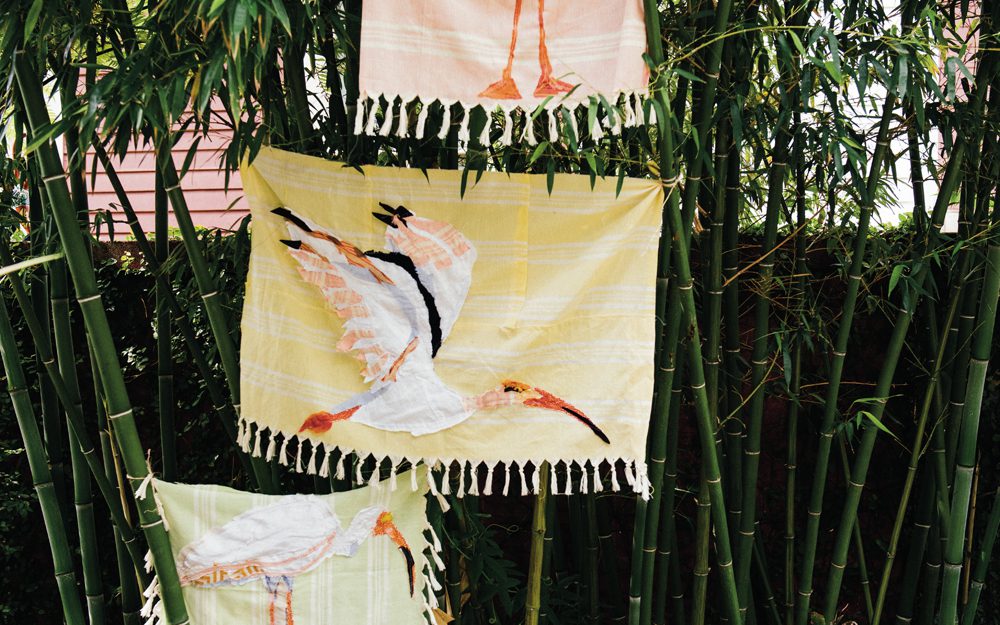A Swamp Tour Through Tapestries: Frances Rodriguez at Steve Martin Fine Art
Jacob Kiernan examines Frances Rodriguez's collaged textile works that depict Louisiana wildlife.

Works from Frances Rodriguez's Prayer Flag Birds series, 2015, in the garden of artist Elizabeth Eckman. Photo by Rush Jagoe. Courtesy the artist.
...A constellation of snowy egrets perched in the bare cypress trees, watching, quiet, still.
Barb Johnson, “If the Holy Spirit Comes For You”
The great egret, like its cousin the ibis, is a water dwelling heron with opalescent plumage. It has a straight, yellow beak and snowy nuptial ornamentation. The ibis—a stout companion of the egret—has a pink bill that curves down toward the water in which it wades. Both are native to the swamps of Louisiana. And both are vividly depicted in “Creatures of the Waterline,” Frances Rodriguez’s latest exhibition at Steve Martin Fine Art.
The gallery contains a menagerie of textile creatures hanging from the walls. Swamp birds, a school of warm-water fish, and a pair of six-foot-long alligators dominate the room. The creatures are roughly stitched together from a colorful array of fabrics. The unhemmed materials give the impression of movement—the ibis launches into flight, the trout splashes across a brick wall.
Tapestries, of course, have roots in ancient cultures throughout the world. More recently, the form has been utilized by contemporary artists, wishing to redefine its boundaries. Kiki Smith employed computerised Jacquard looms to digitally inscribe her drawings of woodland animals onto wall hangings. El Anatsui used copper wire and metal bottle caps to recreate the traditional kente cloth of South Ghana. Mike Kelley dismembered dolls, and Jim Hodges ripped apart jeans to create elaborate hanging tapestries.
Frances Rodriguez’s work is a welcome addition to this conversation. She grants her creatures a playful warmth—evocative of animals projected onto the walls by a magic lantern. Much like local artist Gina Phillips, who appliqués fabrics atop acrylic paintings, Rodriguez has been gathering her materials from friends and relatives for several years. Some samples she made on a loom during college; others she collected from family—her husband’s old linen pants with one too many stains, her grandmother’s muumuu from the 1970s.
Yet her creatures have an exactitude of taxonomy that exceeds the domestic sphere. The coloring and curve of the ibis’ bill are recreated meticulously. The bend of her egret’s neck is unmistakable to any New Orleanian. Many of the creatures, Rodriguez explains, are animals she encountered when walking with her daughter around Bayou St. John.
Underlying Rodriguez’s work is a powerful environmentalism specific to New Orleans. Climate change and disasters such as Deepwater Horizon have put indigenous species at increasing risk. Rodriguez explains, “My hope is that a person entering the installation will experience the simultaneous humor, quietude, and sense of possibility, as well as a deep respect for these creatures.” Rodriguez brings these creatures to life with a ludic touch that remembers the pleasure of seeing them for the first time, yet her tapestries are a serious reminder of what we will lose if we do not change our habits of consumption.
Editor's Note
“Creatures of the Waterline” is on view through November 2, 2015, at Steve Martin Fine Arts (624 Julia Street) in New Orleans.



